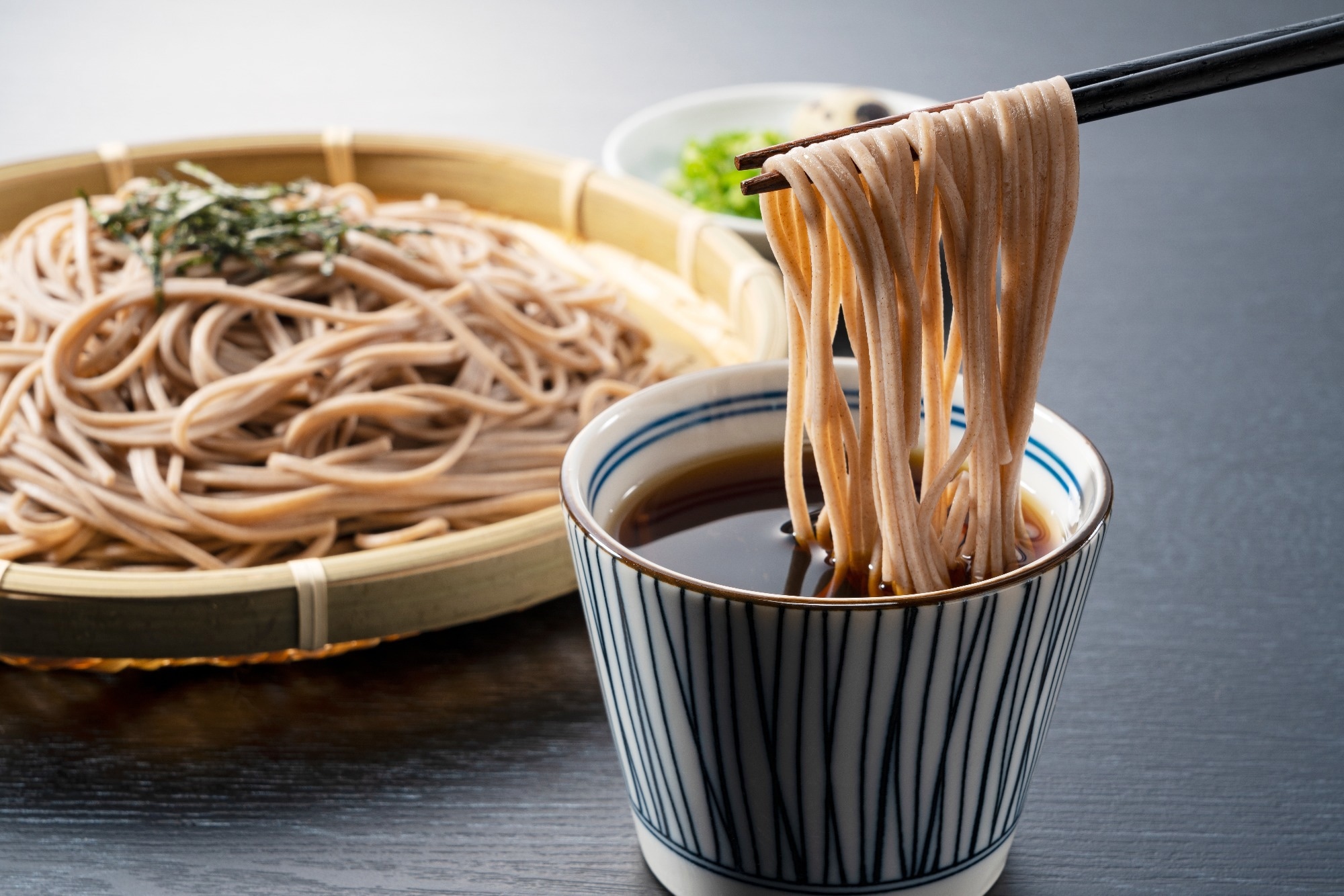Introduction
Traditional roots of soba
Nutritional composition of buckwheat soba
Health benefits of soba
Latest scientific findings
Culinary and practical applications
Safety and considerations
Conclusions and future perspectives
References
Further reading
Discover how soba, Japan’s buckwheat noodle, blends tradition with science by delivering unique bioactive compounds that support heart health, digestion, and modern gluten-free diets.
 Image Credit: masa44 / Shutterstock.com
Image Credit: masa44 / Shutterstock.com
Introduction
Soba are Japanese noodles traditionally made from buckwheat flour. While buckwheat (Fagopyrum esculentum) is botanically a pseudocereal of the Polygonaceae family, it has long been integrated into Japanese cuisine as both a staple and a cultural symbol, particularly within Edo-period food traditions.2
Traditional roots of soba
Soba is a general term used to describe buckwheat-based noodles consumed throughout East Asia, with numerous Japanese variations including jinenjo, mugwort, cha, and ito soba. In Japan, soba became a popular urban dish during the Edo period (1603–1868), where it was sold at street stalls and associated with everyday dining culture as well as ritualized year-end meals (toshikoshi soba). Traditional formulations include handmade 100% buckwheat soba to blends, with all soba noodles in Japan including at least 35% buckwheat.2
Soba noodles can be served hot or cold, with mori considered a classical meal that consists of boiled soba noodles that are subsequently chilled and eaten with a soy-based dip. Regional and seasonal varieties can also include wild yams, green tea, mugwort, or seaweed.2,3
Nutritional composition of buckwheat soba
Soba noodles consist of complex carbohydrates that provide consistent energy, in addition to modest amounts of plant-based protein with a well-distributed amino acid spectrum. Soba is also rich in numerous micronutrients, the most notable of which include magnesium, manganese, copper, phosphorus, and several B-complex vitamins that are concentrated in the outer layers of the groat and retained when minimally refined.4
Soba buckwheat also contains phytochemicals with antioxidant potential, particularly the flavonoids rutin and quercetin, which have been linked to vascular integrity and anti-inflammatory activity.5,4
When soba is produced from 100% buckwheat, it does not contain gluten and, as a result, can be safely consumed by individuals with celiac disease or other forms of gluten intolerance. However, many commercial noodles like hachiwari are mixed with wheat flour to improve dough handling, which introduces gluten and increases the risk of cross-contamination in shared milling or manufacturing lines.6
Health benefits of soba
For cardiovascular health, both rutin and quercetin within soba support capillary strength and reduce oxidative stress. These effects are accompanied by the activity of buckwheat-derived peptides, which inhibit angiotensin-converting enzyme (ACE) activity, thereby improving vascular tone and circulation.1,5
Buckwheat noodles are digested more slowly than refined wheat products, which leads to reduced starch amylolysis and more consistent post-meal glucose responses. Resistant starch, d-chiro-inositol-rich fagopyritols, and antioxidant peptides similarly support glycemic control.4
For digestive health, buckwheat supplies dietary fiber, especially when less-refined flours are used, which promotes regularity and a healthy microbiome. Importantly, milling processes that remove husk and bran reduce the fiber content of these products.4
For weight management, lysine-rich plant protein and resistant starch in soba promote satiety, which subsequently reduces excess energy intake. Studies indicate that buckwheat protein fractions may also enhance lipid metabolism and lower serum cholesterol levels.4,5
Making Soba: Japan's Everyday, Special Occasion Noodle
Latest scientific findings
In vitro, quercetin exhibits strong radical-scavenging and reducing capacity, while rutin is considered a metal chelator. These polyphenols also inhibit advanced glycation end-product formation and downregulate inflammatory mediators like prostaglandin E₂ (PGE₂), interleukin-8 (IL-8), and monocyte chemoattractant protein-1 (MCP-1) through cyclooxygenase-2 (COX-2) pathways. Rutin has historically been associated with low-density lipoprotein peroxidation resistance and vasoactive effects, further demonstrating its cardiovascular benefits.5
Emerging studies are continuing to explore the potential therapeutic activity of bioactive components isolated from buckwheat proteins. For example, the high-quality amino-acid profile and processing approaches used to produce soba products provide the foundation for peptide-focused research with potential antihypertensive and cholesterol-lowering effects.1
Culinary and practical applications
Soba noodles are highly versatile and can be enjoyed in many ways. Zaru soba, for example, is a traditional cold dish in which noodles are consumed with tsuyu, a dipping sauce. Hot preparations, such as kake soba or tempura soba, utilize the nutty flavor of buckwheat to complement the broth.2
Buckwheat is commonly used in the development of gluten-free food products; however, manufacturers will often incorporate additional ingredients into these formulations to achieve the appropriate texture. Hydrocolloids like xanthan or sodium alginate, calcium hydroxide, pre-gelatinized starches, as well as extrusion processes, may be used in the production process to improve these characteristics.In fact, some formulations will incorporate vitamin D2-enriched shiitake or seaweed-derived calcium.1
Soba noodle products vary widely in their buckwheat content, thus emphasizing the importance of carefully reading labels, particularly for individuals with a gluten sensitivity. Whereas handmade soba may consist purely of buckwheat, many commercial blends are approximately 60% buckwheat and 40% wheat.3
Consumers are advised to avoid wheat-heavy ‘soba-style’ noodles if they maintain a gluten-free diet. If additives are incorporated into these products, simple formulations or those that preserve rutin should be selected.5
 Image Credit: S.O.E. / Shutterstock.com
Image Credit: S.O.E. / Shutterstock.com
Safety and considerations
Buckwheat allergy is rare; however, it can cause serious reactions. Reports from Japan, Korea, and China note that anaphylaxis has occurred in sensitive individuals, making labeling essential. Individuals with known food allergies who consume soba are advised to start with small portions and then monitor themselves for symptoms such as hives, swelling, wheezing, and/or digestive upset.4
Commercial soba noodle products are often manufactured with wheat; therefore, individuals with celiac disease or gluten intolerance should only consume products that are clearly labeled to be 100% buckwheat.6
Cross-contact can occur when gluten-free and wheat pasta share the same water, or when fryer oil is used for both. Thus, using dedicated water/utensils or rinsing cooked pasta under running water can reduce the risk of contamination.6
Conclusions and future perspectives
Soba is a historic staple across East Asia. As a nutrient-dense grain, buckwheat is a gluten-free source of complex carbohydrates, well-balanced plant protein, fiber, vitamins, and minerals.
In comparison to whole wheat products, buckwheat noodles exhibit slower starch breakdown and more favorable metabolic responses. Buckwheat is also rich in polyphenols like rutin and quercetin, as well as bioactive peptides with ACE inhibitory activity.1,5,4
Optimizing flour quality, formulations, and noodle processing has the potential to preserve the integrity of bioactive compounds while improving texture. Recent texture research suggests that tartary buckwheat in particular enhances elasticity and sensory properties compared to common buckwheat varieties. These product improvements could expand the utility of soba and buckwheat-derived ingredients for producing gluten-free functional foods and preventive nutrition strategies.3
References
- Puligundla, P., & Lim, S. (2021). Buckwheat noodles: Processing and quality enhancement. Food Science and Biotechnology 30(12); 1471-1480. DOI:10.1007/s10068-021-00960-6, https://link.springer.com/article/10.1007/s10068-021-00960-6
- Stalker, Nancy K. (ed.), Devouring Japan: Global Perspectives on Japanese Culinary Identity (New York, 2018; online edn, Oxford Academic, 19 Apr. 2018), DOI:10.1093/oso/9780190240400.001.0001, https://academic.oup.com/book/6289
- Hatcher, D. W., Bellido, G. G., Anderson, M. J., et al. (2011). Investigation of empirical and fundamental soba noodle texture parameters prepared with tartary, green testa and common buckwheat. Journal of Texture Studies 42(6); 490-502. DOI:10.1111/j.1745-4603.2011.00310.x, https://onlinelibrary.wiley.com/doi/10.1111/j.1745-4603.2011.00310.x
- Sofi, S. A., Ahmed, N., Farooq, A., et al. (2023). Nutritional and bioactive characteristics of buckwheat, and its potential for developing gluten‐free products: An updated overview. Food Science & Nutrition 11(5); 2256-2276. DOI:10.1002/fsn3.3166, https://onlinelibrary.wiley.com/doi/10.1002/fsn3.3166
- Giménez‐Bastida, J. A., Zielinski, H., Piskula, M., et al. (2017). Buckwheat bioactive compounds, their derived phenolic metabolites and their health benefits. Molecular Nutrition & Food Research 61(7). DOI:10.1002/mnfr.201600475, https://onlinelibrary.wiley.com/doi/10.1002/mnfr.201600475
- Damasceno, R. P. B., Zandonadi, R. P., Mendes, M., et al. (2024). Risk of gluten cross-contamination due to food handling practices: a mini-review. Nutrients 16(8). DOI:10.3390/nu16081198, https://www.mdpi.com/2072-6643/16/8/1198
Further Reading
Last Updated: Sep 17, 2025